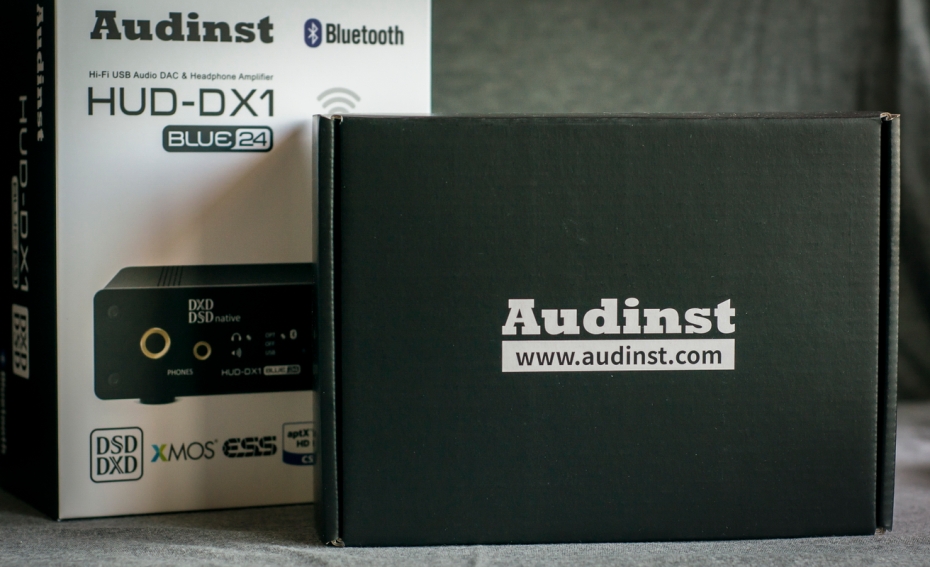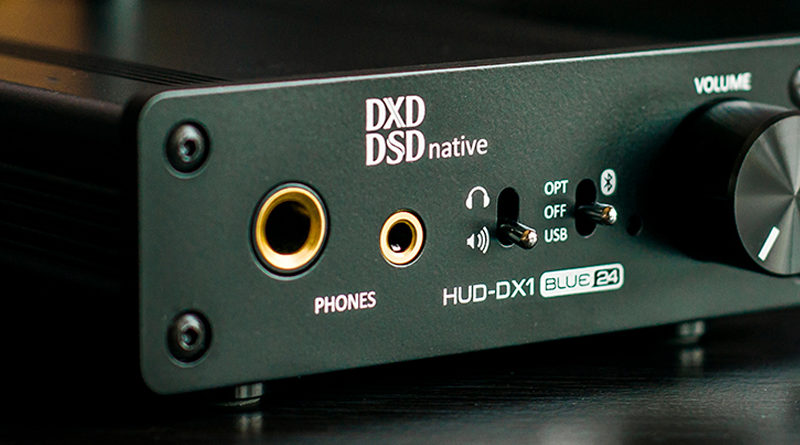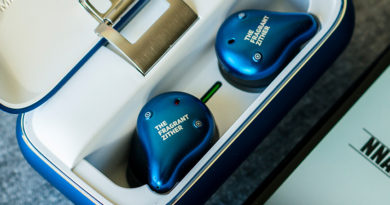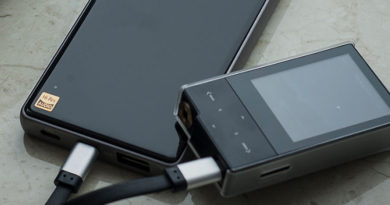Audinst HUD-DX1 Blue24 — mighty flagship DAC& with 24bit wireless audio

Sometimes is it good to get a rest from talking about IEMs of various size and shapes and jump into something more sophisticated that drives this equipment. Audinst is a brand for PC-based Hi-Fi audio components, located in South Korea and established in Y2009. Imposing amount of nominations and awards since than in respected Japan VGP and several other contests won by different products, especially the HUD series of USB DAC&s. The latest one and current flagship in the lineup is HUD-DX1 Blue24 was released in May 2019 and is a topic for my review today.

Audinst HUD-DX1 Blue24 technical specifications:
- Type: USB DAC& with wireless HD audio
Hardawre part:
- D/A Converter: ESS9018K2M
Type: 32-bit Hyperstream Reference Stereo DAC
DNR: 127㏈
THD+N: -120㏈ - OPAMP:
Operating Voltage: ±12V(with DC Adapter), ±5V(USB Bus Power), Inverted circuits
I/V Converter: MUSES8920E (SMD x 2)
Differential Amplifier: LME49720NA (DIP)
Line Out: OPA2134PA (DIP)
Headphone Out: TPA6120A2 (SMD) - Bluetooth aptX HD:
Controller: CSR8675
Bluetooth specs: 5.0
Supports: 24bit/48㎑
Codecs: AAC / SBC / aptX / aptX HD - Digital Input (PCM Only):
Type: S/PDIF Optical on TOS-LINK 44.1~192㎑
Format: IEC-60958, S/PDIF Compatible
Sample rate detection: 44.1 — 192.0㎑ - Headphone Output:
Type: 6.35㎜ Stereo phone jack / 3.5㎜ Stereo mini 4-pole jack
Max Out Level: ±10Vpp@600Ω (When removing the gain jumper)
Max Output Power: 1.5W @ 32Ω
Output Impedance: 2Ω (Load: 16Ω ~ 600Ω) - Line Output:
Type: Unbalanced RCA
Level: ±3.2Vpp max
Impedance: 200Ω - USB Audio:
Type: max 32bit/384㎑, USB 2.0 High-Speed
OS Support: Windows 7 / 8 / 8.1/ 10, Mac OSX compatible - Power Supply: USB 5V or DC adaptor 12 — 15V

Playback compatibility:
- DSD Playback:
Native DSD Support: DSD64 (2.8㎒) / DSD128 (5.6㎒) - DXD Playback:
DXD Support: DXD 24bit/352.8㎑ ~ 32bit/384㎑ - PCM Playback:
Bit depth: 16 / 24 / 32-bit
Sample rate: 44.1 — 192.0㎑ - MQS Playback:
Sample rate: 96.0 — 192.0㎑
Physical:
- Input selection switch: S/PDIF Optical + Bluetooth / OFF / USB
- Output selection switch: Headphones / Line out
- Volume dial: potentiometer
- Inputs: USB / S/PDIF Optical + Bluetooth
- Outputs: RCA line out / 6.35㎜ / 3.5㎜ headphones
- Dimensions: 104(㎜) x 120(㎜) x 34(㎜)
- Weight: 310g
You can buy Audinst HUD-DX1 Blue24 on Ebay
Also available at Audinst offical store

Packaging, design and build quality:
HUD-DX1 comes in pretty large box wrapped with extra cardboard layer that contains high quality graphics and prints describing the product. Complete technical specifications and long list of all embeded features gives the full understanding about the product at a first glance.

The box itself has a strict black design with brand name as the only element and foldable top cover. Inner box compartment is devided into two layers: HUD-DX1 rests on top and secured by special foamy insert while the rest of the accessories are located underneath, stored in dedicated bags and protected by the additional cover.

Packaging is very neat and feels very durable to stand against unappropriate treatment during long shipping journeys. Boxes of similar products that originated from China and landed at my door was less impressive in terms of design, print quality and durability.

Box contents:
- Audinst HUD-DX1 Blue24 DAC&
- DC, 15V/1A power supply
- USB type B -> USB type A cable
- A set of aditional rubber legs with the adhesive (4 pcs)
- Hex-screw tool (for removing faceplate / volume dial)
- User manual

Physical design of HUD-DX1 is not new, similar approach is shared across many other brands for such kind of equipment. Material for all of the parts is aluminum, painted in black with matt finish, with separate front and back plates attached to unibody chassis with the screws.

Chassis have special guides inside that hold the main board at place. Main difference between the products are usually spotted when looking at quality of the cutouts, painting and prints closely. Audinst has done a perfect job here — everyhting is super neat. All input/output panel cutouts are perfectly aligned with the physical elements, all edges are pocessed well.

Control switches and volume dial feel silky-smooth in operation. Absolutely nothing to complain about. Hopefully, Audinst would introduce white color option of HUD-DX1 Blue24 similar to HUD-DX1 V2 as it looks much more appealing due to the eye-catching contrast of outlines for all physical elements at front and back panels.

Let’s now take a look inside and try to identify all declared HW elements on the main board. The only tool needed to get the main board out is the provided hex-screw driver. First — unscrew volume dial stopper and proceed with 4 screws on the face plate. The main board should easily slide out of the chassis afterwards.

As you can see on the pictures all declared HW components are present. NICHICON UKA series aluminum electrolytic capacitors, XMOS chip, MUSES, TPA, together with LME and OPAMP on DIP which also means that there is a chance for the further upgrades and experiments with the sound.

Gain jumpers that should be removed to release full output power potential are located in the headphone output / amplification area. This is necessary in case of using >300Ω headphones.

Bluetooth receiver is combined with SPDIF/Optical and looks as an add-on board which is easily removable. The processes of soldering, component alignement and final QC seem to be perfecty debugged and fully tuned at the factory.
Preparing for use:
There are several usage senarios applicable to this DAC& that should be considered:
- Using it with PC or MAC over USB / TOSLINK
- Using it with smartphones or other audio sources over USB OTG / TOSLINK
- Using it with any audio source as wireless Bluetooth HD Audio receiver
First option requires to have the dedicated audio driver that is available for download from Audinst official website. This is ASIO driver developed by Thesycon (German SW developing company) and adopted by Audinst to comply with all features of HUD-DX1 series DAC&s. Native Windows 10 driver, if used instead, would not provide similar functionality and would pass the stream over WASAPI instead of ASIO.

If in case of some vendors from China that are using unreliable and unsigned TUSB ASIO driver I would insist on using Win10 native WASAPI options, the driver provided by Audinst is free of any glitches and, moreover — has very small audio lag that allows you to comfortably watch videos. So, just download and install the driver prior to plugging HUD-DX to your PC. Of course, you would need the provided USB cable for that.

Another option is to pass the music from your smartphone or other USB OTG equipped device to this DAC. This is more difficult as the necessary cables are not included. Regular OTG microUSB or microUSB type-C -> USB type-B should do the trick. I have tested my Xiaomi smartphone with microUSB -> USB A (female) adapter that was connected to stock USB cable provided by Audinst — everything worked as expected. Using HiBy Music App to pass the stream to USB device.

And the last option is to connect to HUD-DX1 Blue24 with Bluetooth. Best to be used with any device capable of aptX-HD codec. In this case you’d get 24bit/48kHz wireless audio. No problems found during discovery and pairing process — HUD-DX1 identifies itself as Audinst Blue24 among available Bluetooth devices. You just have to put the input mode selector switch to OPT/Bluetooth position. External 2dB antenna provides extended range of reliable signal reception. Even a couple of walls are not a huge obstacle for the fluent performance.

Note: Audinst recommends to use the provided 15V DC power supply instead of using 5V over USB port for the sake of best audio quality, no voltage drops and sufficient power to drive higher loads.
Device in operation:
HUD-DX1 is a simple device with intuitive controls and working modes. Input selector switch is used whenever you want to change from USB to Optical/Bluetooth or switch device OFF and output selector allows to send audio to active speakers or headphones. No more controls except the volume dial which is linear and smoothly increasing and decreasing the volume, utilizing 100% of full travel. This is important because many cheaper products would have discrete volume dial with severe dial position to real volume output mismatch. It usually results into sudden increase in volume from 0 to a certain minimum at ~10° travel and audible volume steps during operation. HUD-DX1 is true analog and very linear in this respect.

There is a small LED indicator located between volume dial and mode selector that informs of the different workig states:
- OFF (mode selector in OFF position)
- Orange (USB mode ON, no data stream)
- Green (USB mode ON, acting) / (OPT/Bluetooth ON)
Switching between different outputs happens with no lag and audible clicks. Going between modes takes the time necessary to locate the evice, acquire stream and fill the buffers. But the glitch free and consistent results show that the hardware and software parts were designed wisely. Other devices that I have would hang up and require reboot when trying to cycle through modes and outputs with the same frequency.

Another outstanding results worth mentioning is the output power of HUD-DX1 amp section which results in high drivability potential. Power goes as high as 1.5W@32Ω which is superior to any other device ever mentioned in my reviews. This is the first time I was afraid of burning down my reference full size headphones and IEMs. Half of volume dial travel is the maximum I could withstand and my IEMs would handle… A bit more volume needed to get 150Ω headphones feel uncomfortable. Three times as much as my most powerful DAP would produce. Consequently, 600Ω headphones should be perfectly driven by this device.
Despite 15V power supply, no heating issues while handling 24bit/192kHz stream and using 150Ω headphones were noticed. HUD-DX1 aluminum case was fixed at about room temperature and no further fluctuations. It seems that the main board location in chassis with sufficient space between the top and bottom walls dissipates the heat effectively.

Sound quality:
In order to carry out adequate audio test with comprehensive description of the results, I have decided to describe the sound of HUD-DX1 and to compare it to other similar devices: Tempotec Serenade iDSD and Hidizs Sonata DH1000. Moreover, HUD-DX1 would also be compared to HiBy R6Pro as one of the most powerful DAP with my favorite reference sound.
Reference headphones and IEMs used for this test: Audio Technica ATH-M50 + Tanchjim Oxygen. Speakers: Edifier M1100.

Lows and midbass:
HUD-DX1 Blue24 is able to resolve lower range with great amount of textures, moreover it delicately delivers bass with perfectly outlined boundaries in just-the-right amount. Extension of the lower end is very good, bass is decaying neither too fast or too slow. Lows show good clarity, have enough of volumetric feel and perfectly separated from interferening with mids and treble. Bass is not accented but fully perceptible, enriching the sound and making the stage wider. Excellent tuning for balanced lower range delivery.
Midbass section is similarly great: tight and powerful. Amount of air and dynamics is enough for natural articulation while reproducing drum section. Sound stays neutral and balanced here — no weight added to lower or higher portion.

Mids and vocals:
The most of the resolving potential pops in the mids while this section still remains neutral in overall. Vocals are rich, quite thick and full-bodied. They play a central role of the scene as it should be in monitor-like sound. No tendency towards emphasizing female vocals or upper treble range instruments has been spotted. No harsh and screaming notes. Male and female voices sound natural, fully exposed and both have a slight touch of warmth. Plenty of micro detalization is perceived with the most of the instruments while all are evidently spaced across the stage. Impressive instrument separation also dedicates much to enlarged stage depth. In overall, mids feel smooth and natural, more than adequately detailed and free of any disturbances.

Treble:
Treble portion has a slightly higher presence in the entire sound picture that HUD-DX1 produce and perceived as more pronounced than mids or lows. Treble is clear, crisp and not obscure by other sounds. Its extension and microdynamics are outstanding but not too cold or vivid. Minor amount of additional sibilances is produced by this range that might slightly affect vocals and some instruments in mid range but it greatly depends of the quality of the recording and it is initial mastering EQ. Too bright original sound might be affected and more neutral or bassy tracks are not. So, this range is accurate in general and totally compensates good bass presence without producing piercing effect and allowing long listening sessions.

Soundstage:
HUD-DX1 is definitely one of the most capable devices in terms of building the imaginary stage width and depth. Especially when paired with the IEMs or headphones also capable of the same. Stage is dramatically large with precise instument locations, defined contours and good layering between the ranges.
Audinst HUD-DX1 Blue24 Pros and cons:
V/S Tempotec Serenade iDSD:

Pros:
- Better texturing and contouring of lows
- More resolution on mids
- More extended and vivid treble
- Much higher power output (1.5W@32Ohms)
- Wireless audio (Bluetooth aptX-HD audio)
- Better physical controls
- Volume dial utulizes full travel
- Superior ASIO driver
- Better packaging
- May work with no external power supply
Cons:
- No
V/S Hidizs Sonata DH1000:

Pros:
- More resolution on mids
- More extended and vivid treble
- Larger soundtage
- More native formats supported (DXD, MQA)
- Much higher power output (1.5W@32Ohms)
- Wireless audio (Bluetooth aptX-HD audio)
- 6.35mm output
- TOSLINK
- Physical controls
Cons:
- No balanced 2.5mm output
- No in-built battery
- No additional OTG cables among box contents
- Cannot be used as portable DAC&
Therefore, if the main intention is to drive headphones with up to 150Ohms on the go — Hidizs Sonata DH1000 would be a better choice. But in case if there is no need to carry such device in your pocket or if your headphones require more powerful output — Audinst HUD-DX1 Blue24 is the most powerful option with the highest sound quality.
V/S HiBy R6Pro (only sound & audio HW):

Pros:
- More extended and vivid treble
- Slightly more musical and less neutral
- Much higher power output (1.5W@32Ohms)
- 6.35mm output
- TOSLINK
- Superior ASIO driver
Cons:
- Treble is less accurate
- Mids are less thick
- No LDAC, UAT Bluetooth codecs
- No balanced outputs

Conclusion:
Korean engineers behind Audinst brand has clearly shown what a mature flagship DAC& should be. HUD-DX1 Blue24 is a mighty device with clever audio hardware design, outstanding power output specifications and driveability, glitch-free and reliable operation in either of the numerous usage scenarios. Even the driver from German audio software develping company was adopted to utilize the full product potential. Such qualitative approach is creating much more value and satisfaction for the potential customer in contrary to focusing on quantity and forgetting to polish the product prior to its market release. Guess which one would have a longer life-cycle and which brand would win more from the recurring customer interest? Audinst has taken the right route and delivers the best experience out of the box. HUD-DX1 Blue24 is fully functional high-quality audio device with no compromises. Highly recommended as a desktop DAC& to drive the loads up to 600Ω, to provide best audio quality to active speakers or act as DAC&preamp for home audio system.
You can buy Audinst HUD-DX1 Blue24 on Ebay
Also available at Audinst offical store




